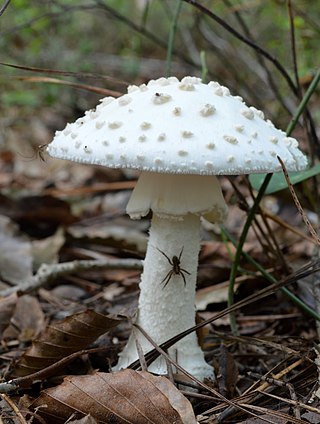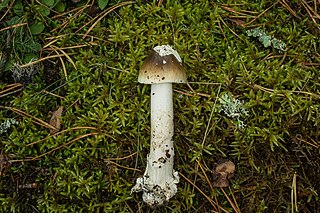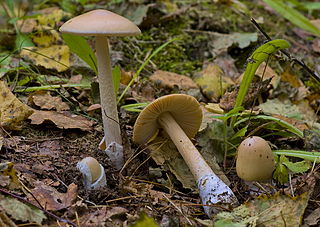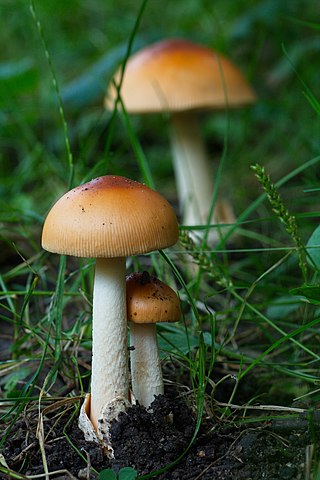
Wilson's snipe is a small, stocky shorebird. The generic name Gallinago is Neo-Latin for a woodcock or snipe from Latin gallina, "hen" and the suffix -ago, "resembling". The specific name delicata is Latin for "dainty".

Limacella is a genus of mushroom-forming fungi in the family Amanitaceae in order Agaricales. Some of the species have been classified as members of genus Lepiota. Limacella was described by mycologist Franklin Sumner Earle in 1909.

Amanita brunnescens, also known as the brown American star-footed amanita or cleft-footed amanita is a native North American mushroom of the large genus Amanita. It differs from A. phalloides by its fragile volva and tendency to bruise brown.
Amanita elliptosperma, commonly known as the Atkinson's destroying angel, is a basidiomycete fungus, one of many in the genus Amanita. Although its toxicity is not confirmed, it is assumed to be deadly poisonous like its close relatives. Originally described from North Carolina, it is found in the eastern United States from New England to eastern Texas.

Limacella glischra is a mushroom species in the family Amanitaceae. It was first named as a species of Lepiota by Andrew Price Morgan in 1906; William Alphonso Murrill transferred it to Limacella in 1914.

Amanita suballiacea is a species of Amanita found in US coast of the Gulf of Mexico occurring with Quercus and Pinus.

Amanita veldiei is a species of Amanita found in South Africa

Amanita canescens is a species of Amanita found from Connecticut to Alabama, United States.

Amanita calyptratoides, or Peck's candlestick amanita, is a species of Amanita found in southern California

Amanita carneiphylla is a species of Amanita found in Western Australia growing among Eucalyptus, Banksia, and Allocasuarina

Amanita betulae is a species of Amanita found in growing in birch and mixed hardwood in Europe

Amanita gioiosa is a species of Amanita found in Italy growing among Arbutus, chestnut, oaks, and pines.

Amanita protecta is a species of Amanita found in California growing solitary among Quercus agrifolia and Monterey pine.

Amanita olivaceogrisea is a species of Amanita found in England, Estonia, France, Latvia, and Sweden.

Amanita rhacopus is a species of Amanita found in east coast of the United States

Amanita flavescens is a species of Amanita found in Sweden and Norway.

Amanita fuligineodisca is a species of Amanita found in Honduras to Andean Colombia.

Amanita arctica is a species of Amanita found in Greenland and Norway.

Amanita subnudipes is a species of Amanita found in Italy.

Zhuliangomyces illinitus is a mushroom-forming fungus species of genus Zhuliangomyces in the family Amanitaceae in the order Agaricales. It has been known most recently as Limacella illinita. Also known previously as Agaricus illinitus and Mastocephalus illinitus. This fungus is known for its distinctive slimy cap. Z. illinitus is commonly known as the dripping slimecap or the overflowing slimy stem.


















